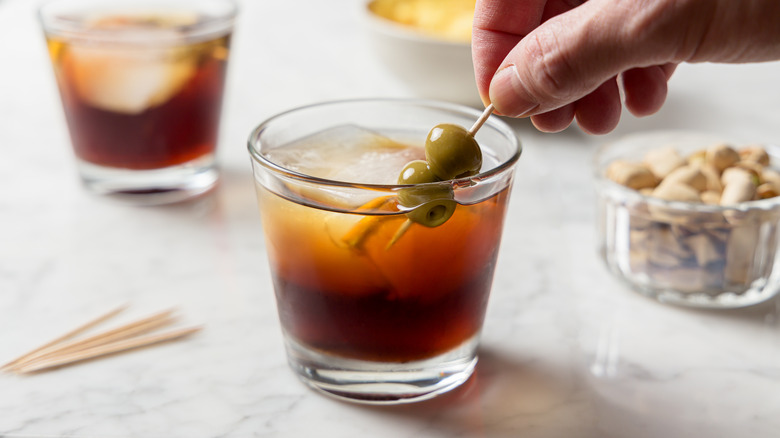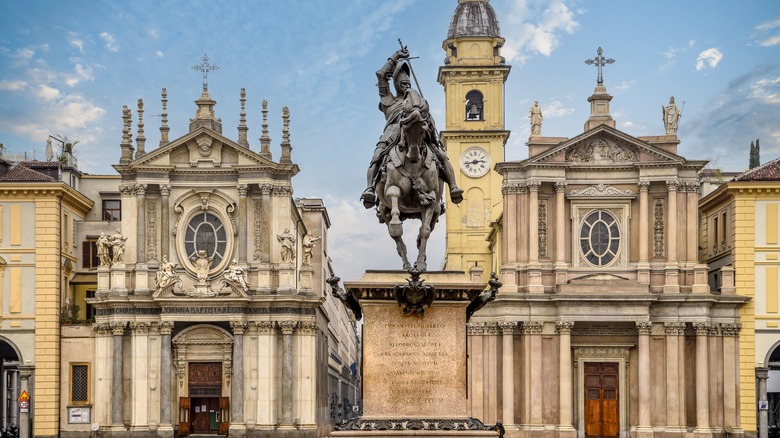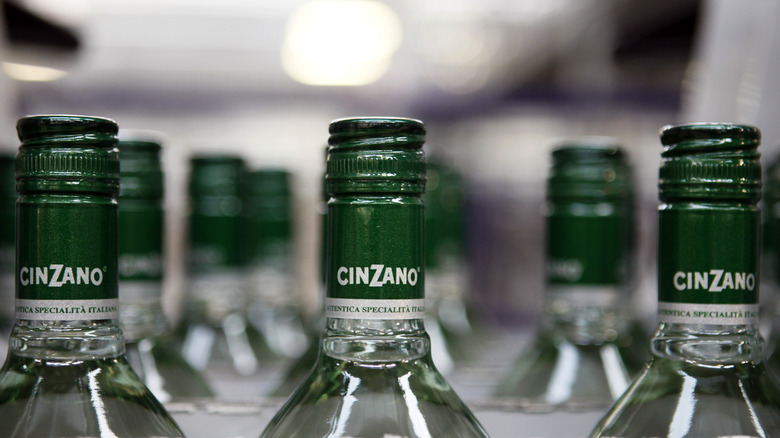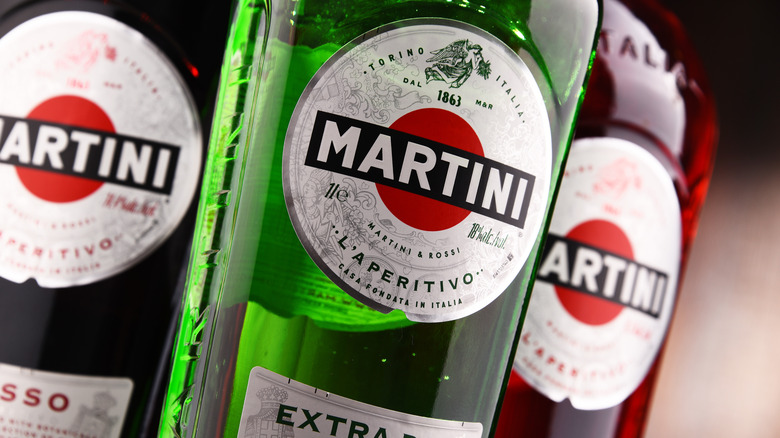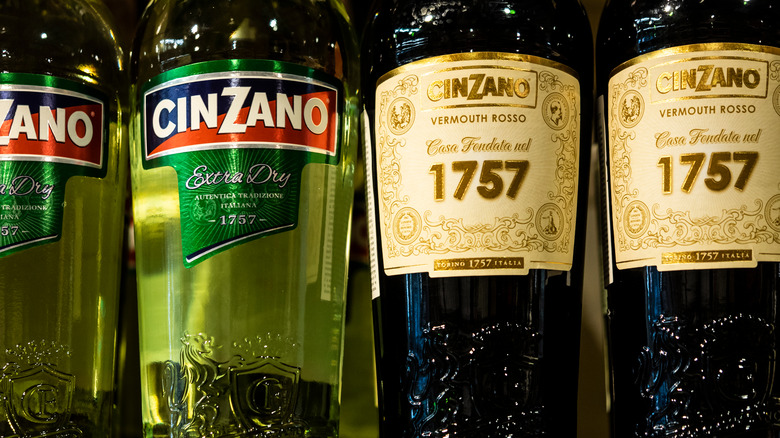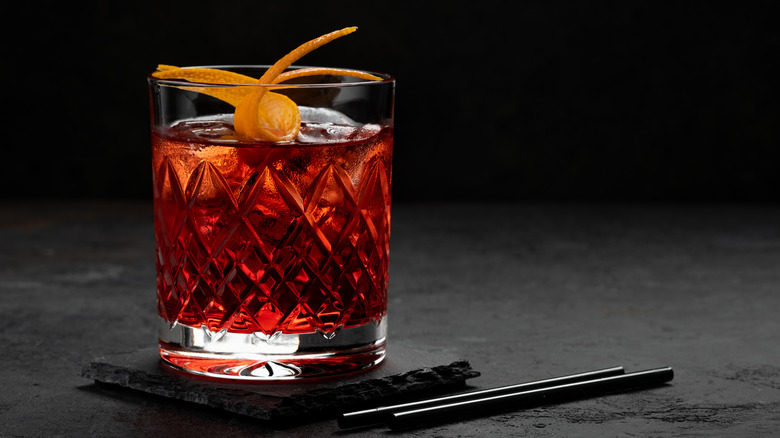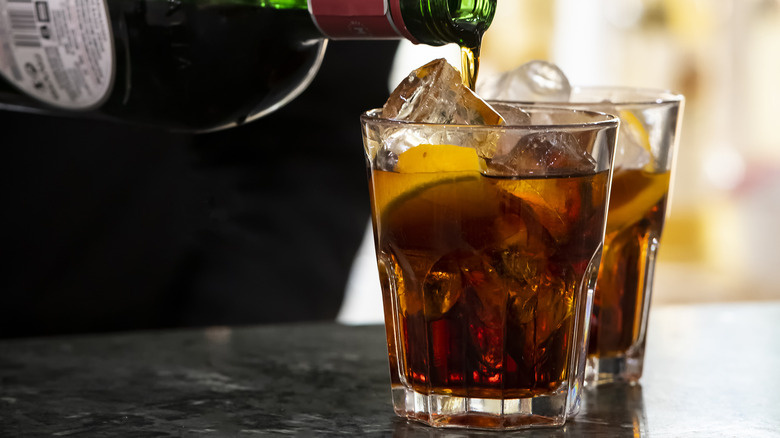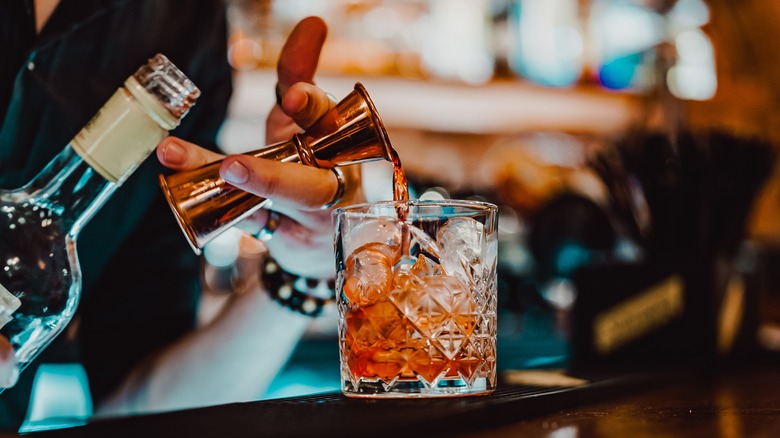Everything You Need To Know About Vermouth
Vermouth is fortified wine infused with the flavors of various herbs, plants, and spices, depending on the producer. The botanicals that go into each vermouth are entirely up to the winery making it, so there are no two bottles of vermouth on the market that are exactly the same, including ones of the same style.
Decades ago, vermouth was fully in its stride, as popular brands dominated bars around the world. After dying down, it seems as though the botanically rich spirit is undergoing a renaissance, as nuance and complexity in spirits are being encouraged and savored more than ever. The spirit has a rich history and cultural significance in Europe, with origins and popularity dating back centuries, so it is only right that vermouth is given the respect it deserves in the modern-day drinks space and cocktail re-boom.
The liqueur is most commonly referenced as an essential ingredient in iconic cocktails like the Martini, but this spirit offers so much more than just rinsing a glass to mildly tone down a strong liquor. Quality vermouth is delicious enough to be sipped on its own, as well as prominently in a wide array of different cocktails.
Your home bar is not complete with a quality bottle and finding your preferred brand either generally or in specific cocktails is part of what makes the endless world of drinks so exciting. Here is everything you need to know to help give you a head start.
History of vermouth
Vermouth has been sipped by drinkers in the alpine region of Europe for centuries now, the earliest known history of the spirit dating back to the late 18th century in the birthplace and "Kingdom of Vermouth" — Turin, Italy (via Spirits Beacon).
While the practice of infusing wines with botanicals dates back millennia, the vermouth we recognize and enjoy today came about in the 1700s along with Italy's golden era. The city of Turin is located in the region of Piedmont, which was a commercial and cultural hub home to many confectioners, brandy producers, and wineries.
The cafes in Turin reaped all of these benefits and were the common meeting place for friends to meet, chat, and drink. It is here that the concept of the aperitif was organically born, the ritual of an early evening drink to whet the palette as you look toward the night ahead. Sipping fortified wine, aromatized wine, or amaro in the evening became just as common as sipping espresso in the morning.
In 1786, as this new sensation grew, Antonio Benedetto Carpano came up with his own fortified wine recipe for his boss's shop and called it "vermut," or "wormwood" in German. This first commercially bottled vermouth was such a success, it became the favorite drink of Duke Vittorio Amedeo III and of the entire House of Savoy. Consequently, it became the favorite drink of all of Turin, and, from there, the vermouth became the mainstay it remains today.
Types of vermouth
There are several different types of vermouth. Initially, there was only sweet (also called red or Italian) and dry (also called French). Sweet vermouth is used in cocktails like a Negroni or Manhattan, while dry is the type used in a martini, for example. Each style of vermouth is very different from one another in taste, but they also share many similarities.
All vermouth is made the same way — by infusing wine with botanicals, to put it simply. This template leaves much room for experimentation, which is why each style is so different from one another and each bottle from the next. Sweet vermouth, however, is the most robust and nuanced of the three.
Dry vermouth is much more subtle and cooler. These vermouths are less spice-forward and place more of an emphasis on herbs and plants. Although dry vermouths are not as bold as sweet vermouths, they can still have an abundance of flavor notes and be very unique. There are also bottles labeled "extra dry," which just means the alcohol content is a bit higher and the flavor is less potent.
More recently, the emergence of white, or blanc, amber, and rose vermouths has become more common in the market and in the drinking culture. Blanc vermouths are sweetened more than dry vermouths, similar to red vermouths without potent spice. Amber vermouths are very delicate and floral with a strong presence of orange, and rose vermouths are simply vermouths made using rose wine.
How is vermouth made?
Because it serves as the base for all vermouth, the wine is essential, so regional availability and natural sweetness are two common factors considered for selection, per Spirits Beacon. Nowadays, vermouth producers will blend different wines together, picking from various regions to achieve complementary characteristics.
Then, the wine must be fortified, which is now done with a neutral spirit, but commonly used to be done with brandy or grappa. Generally, this step is done simply to enhance the alcohol content, but the choice of alcohol can impart an extra layer of flavor to the final product. All in all, the average ABV of vermouth ends up between 15% and 18%.
Now that the wine has been strengthened, it must be balanced with sweeteners. As stated earlier, the natural sweetness from the wine provides most of the sugar content, but caramelized sugars, honey, or carob syrup are added as well.
Finally, it's time for botanicals. By law, the infusion must include a plant of the Artemisia genus, which includes over 400 species, the two most common being Grand Wormwood and Roman Wormwood. From there, the other ingredients used are free range, but most vermouths utilize the abundant and unique ingredients indigenous to the Alpine region where they are made.
Whatever is chosen can be steeped in the wine, distilled, hot infused, or cold extracted. The result of this infusion can be bottled right away or aged for up to a year to develop the flavor even further.
How vermouth differs around the world
As mentioned above, although the main flavor of vermouth comes from the botanicals used for infusion, every vermouth starts with its wine nonetheless. Therefore, vermouths that are made from different wines will have different characteristics, which is why vermouth varies depending on where it is made. Italian vermouths are mostly produced in the city of Turin in the Piedmont region. Here, the muskat grape is the most readily available and most widely produced for wine-making. These wines are more naturally sweet and require little added sugars later on in the process. This is why Italian sweet vermouths are more commonly sipped straight because the botanicals are more potent and the base wine has a more palatable mouthfeel.
Meanwhile, some vermouths made in France, such as Noilly Prat, are made in the southern part of the country close to the sea. Therefore, this brand's vermouths have a natural briny quality to them due to their proximity to the salty water and air. Lillet, another French vermouth producer, is a proud resident of the Bourdeaux region, so its Lillet Blanc is made mostly using wines from that region. The blend of white wines from here makes for a very complex fortified wine that pairs greatly with the ingredients infused into it.
Spain, meanwhile, is a very unique place to make vermouth. In Spain, many vermouth producers are utilizing access to sherry wines to make the spirit, which incorporates that very specific flavor and added depth.
Which brands of vermouth are best?
Predictably, the best vermouth on the market is the original Carpano Antica Formula, bar none. This sweet vermouth makes a Negroni like no other and so so rich, decadent, and complex that it really does not require any accompaniment other than a glass to sip it from. However, this one-and-only bottle is also quite expensive for vermouth. While this exceptional vermouth is worth its price, there are plenty of less expensive, high-quality vermouths to choose from. Another outstanding Turin-based sweet vermouth is Cocchi di Torino, which is about $10 less.
As mentioned earlier, Noilly Prat is a high-quality and longstanding leader in the vermouth world. Plus, they produce both dry and sweet vermouth and both are easily affordable. Dolin is another France-based vermouth that makes a dry, sweet, and blanc vermouth, all of which are readily available in a 375-milliliter bottle instead of the full 750 milliliters. Not only are these even less expensive, but they also do not carry the risk of spoiling before being finished since it's only a half bottle.
Finally, Martini & Rossi is simply a classic, straightforward, affordable vermouth brand that has been a reliable option for professional and home bartenders alike for centuries. Each of their vermouths is great for cocktails and is quite the bargain. Martini & Rossi may not make the most complex and exciting vermouths out there, but you really can't beat it at its price point.
Is vermouth expensive?
Based on the brands listed above, vermouth is usually an inexpensive addition to your home bar, with prices ranging from less than $10 to over $30, according to Wine-Searcher. Brands like Tribuno and Martini & Rossi are the most affordable options around or below $10, while the holy grail, Carpano Antica, will run about $35. One thing to remember when shopping for vermouth, however, is that generally speaking, you get what you pay for.
Buying a bottle of Carpano Antica Formula is definitely quite an investment in regards to vermouth, but it is, without a doubt, the best vermouth money can buy. Meanwhile, a brand like Tribuno may only cost you about $7, but its quality will be reflective of that. This is not to say it will taste bad, but it is certainly miles away from more expensive bottles of vermouth.
Again, Martini & Rossi are very standard, fairly priced vermouth that will make drinks just fine. For a couple of extra dollars, however, you can begin getting into superior products like Noilly Prat or Dolin which are another step above. Above that, at over $20, more rich and complex vermouths like Lillet Blanc or Cocchi di Torino are other steeper investments but are sure to give you your money's worth. No matter what price range your vermouth shopping falls under, there is a quality bottle out there for you.
The best way to drink vermouth
Originally, vermouth was enjoyed on its own, either neat or just with ice. This remains, obviously, the purest way of enjoying vermouth, but sipping sweet vermouth by itself may not fit the palette of most drinkers. Although high-quality brands make well-balanced, nuanced vermouths, sweet vermouth is still a very punchy spirit to sip straight.
If you want to enjoy a nice bottle of vermouth but sipping it on its own is not for you, a vermouth spritz is an excellent, vibrant, refreshing way to enjoy all of the botanicals in a vermouth with the added accompaniment of sparkling wine and your own favorite garnishes. If a vermouth spritz is your way to go, it is encouraged that you garnish your libation with botanicals also used to make the vermouth. For example, a Lillet Blanc spritz garnished with citrus peels will really punch up the bitter and sweet orange flavor and take the vermouth to a whole new level.
Additionally, vermouth contributes to an endless list of cocktails, some traditional classics, and others modern ones. The Negroni and Manhattan are two sweet vermouth cocktails that really allow you to find your own preferred version. Finding a vermouth that works best for your personal taste makes the cocktail that much better, the same goes for a martini. One of the many great aspects of vermouth is that it is versatile. There are many ways to enjoy it and there is one out there for everybody.
Vermouth is the ultimate aperitif
The role of the aperitif cocktail in cultural and culinary society is a subtle, yet sophisticated one. The act of beginning the evening with a low-ABV cocktail to sip before indulging in a meal has many benefits beyond the pleasure of the drink itself. Translating to "to open," aperitifs essentially prepare your appetite and digestive system. Therefore, once an evening with the company is in full swing, digestion has gotten a head start and will more easily break down the food that enters it.
Along with these health-related benefits, enjoying aperitifs occurs during the time of day when friends and family are greeted, toasts are made to your valued company, or simply when a drink is required at the end of the day. This ritual plays a significant role in drinking culture, and it all started with vermouth.
As stated earlier, the vermouth is responsible for the ritual of the aperitif. It was the drink of choice late in the afternoon at cafes all across Turin and remains a key contributor to the routine. As other iconic liqueurs made specifically for aperitifs have been born since, bottles like Campari and Aperol have vermouth to thank for their existence in the drinks world. Vermouth is the ultimate aperitif, and the many ways you can enjoy it, listed above, help bring everybody into this enlightened realm of imbibing.
Is it actually good for you?
Because vermouth is a wine-baed spirit, it carries all of the health benefits that come with wine. Of course, consumption of alcohol, or anything for that matter, should be done in moderation, but wine and vermouth can be beneficial to your health in a variety of ways.
According to The List, regular wine is ripe with helpful properties such as antioxidants and immunity boosters, and drinking it can also promote good cardiovascular health. Vermouth not only contains these same properties but the plants and herbs used to make it come with their own benefits well. Being a fortified wine, vermouth has a higher alcohol content than regular wine, but one that is not as high as regular liquor.
This, plus the botanicals infused into it, make vermouth great aid to gut health and digestion as well as an anti-inflammatory. This goes back to vermouth benign the original aperitif. Not only is it delicious and a joy to drink, but its benefits also go way beyond tastiness. It can actually improve your body.
In fact, according to Paste Magazine, when the infusion of herbs and spices into wine was first practiced by the Ancient Greeks, it was done so for its medicinal use. While no official studies of vermouth's health benefits have been carried out, many of the botanicals common in vermouth are believed to contain very positive, medicinal properties.
Store your vermouth properly
When you buy other bottles of alcohol for your home bar, you do not usually have to worry about them going bad. Liquors like whiskey or gin and liqueurs like Campari or other mixers take a very long time to spoil, most of them have seemingly infinite shell lives. Unfortunately, this is not the case for vermouth.
Since it is wine-based, vermouth is best kept in the refrigerator after being opened. The cold environment will allow your vermouth to last longer than it would at room temperature. This is because vermouth, like wine, begins to oxidize the moment it is opened. The longer oxidation carries on, the more the flavor and aroma of the vermouth will be altered until it ultimately spoils.
If kept at room temperature, an opened bottle of vermouth will only last up to one month. When kept in the refrigerator, it will last up to three months. Still, however, that is quite a short lifespan for a mainstay member of your home bar.
If you are new to vermouth or want to try a new brand that you have yet, it is recommended that you look for a bottle smaller than a full-sized one. Therefore, you will surely finish it before it oxidizes too much. Plus, a smaller bottle will not take up as much space in your refrigerator.
